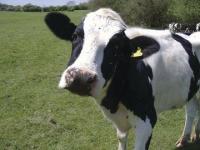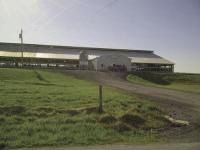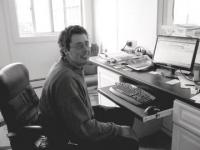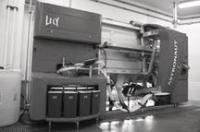Witnessing The Technology Revolution At The Nea Tocht Farm
By Cookie Steponaitis
Down on the farm will never have the same meaning that it used to. Heck, we may even have to rewrite some of the classic songs like Home, Home on the Range, where the robots are milking all day. It has a futuristic tinge to it, doesn’t it? Well, ready or not, the future is now and Ferrsiburgh is one place it is happening.
When Raymond and Linda VanderWey moved to Addison County from New Jersey and started Nea Tocht Farm in 1976, they had no visions of the changes that were coming to agriculture and eventually their farm, but today they are embracing them. “It sure took a while to get used to,” commented Linda, “but we can really see that this is the way to go.” While her sons Sid and Howard VanderWey, representing the second generation on the farm, are firmly in step with the newest changes, Linda is getting used to the stream of people, farmers and just plain curious coming to see the robots and understand how technology has not only caught up with the family farm but transformed it as well.
“While the technology is new to Addison County,” remarked Sid VanderWey, “it has actually been in use in Europe and the Netherlands for over twenty years. My parents have family in the Netherlands who used robots and when we began looking at the possibility of bringing it here in 2010, they were one of the sources of our information.” While labor costs were one issue impacting their decision, the VanderWey’s also based it on the ability to maximize the potential of the cows by milking more efficiently and to reduce stress and quarter damage on the individual cows. This reporter who was taken into the milking parlor and introduced to the Astronaut Robotic Milker, was getting a crash course in individual cow statistics including the pounds of milk, average milk production per day, body weight, body temperature, feed ratio, activity level and much more. The Astronaut proceeds to wash and clean the teats of the cow, attaches the milker and transforms a task that for generations was labor intensive into one that is repeated multiple times a day for the 217 cows that call Nea Tocht their home. The cows are free to move around the barn and approach the Astronaut Robot Milker when they decide they want to be milked. The system is set to parameters put in place by Sid and his brother to establish the guidelines for each cow based on days of milking, breeding plans and percentages of milk. While this reporter watched the process one cow named JFK circled around to be milked three times. Three times the computer refused to engage the process and the cow cycled back out into the barn population. Using the office computer to look up the individual specifics on JFK, Sid VanderWey explained how the cow still had forty minutes before the computer would allow her to be milked again and that on average the cows were being milked three times a day, some more, some less, due to the individual specifics of each animal.
With a maximum focus of sixty cows per robotic station, the VanderWeys have four robots and are the fourth farm in Vermont and the second in Addison County to make the leap to technology based milking parlors. While Nordic Farms in Charlotte went robotic eight years ago, Nea Tocht is the first in Addison County to be a four robot station farm, with some additional two robot station farms and some one robot station farms appearing now around the state. The cows are free to move around the barn and approach the Astronaut Robot Milker when they decide they want to be milked. While Nea Tocht and its cows are all in the full swing of the process now, Sid VanderWey explained that it was a learned process. “It took the herd about three weeks to get the idea,” remarked Sid. “Another three months and they got the idea better and about a year to set the pattern for the barn. Now when cows are added in, the others become the teachers and it takes much less time.”
While the Astronaut robot milking system quickly displaces any misconceptions of robots loose with the cows, there is in fact one little robot who is moving about. While the interview was going on, Sid pushed a button and a device resembling a cross between a large floor sweeper and an ice rink Zamboni came to life and began cleaning up the cow manure on the floor, showing yet another application of technology to the farm.
As Vermont family farms continue to have to evolve, change and improvise to stay strong financially, the VanderWeys see the implementation of this 20 year old European technology as a viable and growing option for family farms. “The company that makes these machines has just opened up a factory in Iowa,” shared Sid. “Now it is possible for a husband and wife to operate a small herd and farm with the assistance of the robotic technology. It allows the farmer to focus on what is important, family life! I have a young son and daughter and this system allows me to spend more time with them and to let them be in the barn safely.”
As the cows continued to move into place and the Astronaut performed its job, the line between futuristic shows and the realities of the present began to merge and what appears to even the most curious observer was a farm family rooted strongly in the traditions of agriculture, family, faith and land that was using the technological revolution to strengthen its position as a viable, sustainable economic entity at a time when family farms are struggling. While Nea Tocht farm is currently one of two robotic farms in Addison County, Sid VanderWey and his family are certain they will not be the last. “Several farmers are watching, some are studying and some already have plans to put in their own systems,” concluded Sid VanderWey. “They stop in at Nea Tocht all the time.”
All the time indeed! Who could have known all those years ago when Linda VanderWey came up with the family farm name it would be so prophetic for its future. Nea Tocht translated means, “Never thought!” Never imagined indeed, the day when down on the farm included some robots mixed in with the cows!




